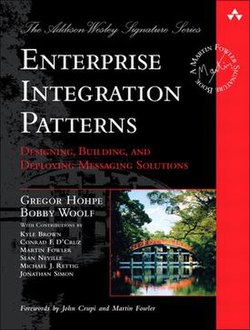|
Enterprise Integration Patterns
Enterprise Integration Patterns is a book by Gregor Hohpe and Bobby Woolf which describes 65 patterns for the use of enterprise application integration and message-oriented middleware in the form of a pattern language. The integration (messaging) pattern languageThe pattern language presented in the book consists of 65 patterns structured into 9 categories, which largely follow the flow of a message from one system to the next through channels, routing, and transformations. The book includes an icon-based pattern language, sometimes nicknamed "GregorGrams" after one of the authors. Excerpts from the book (short pattern descriptions) are available on the supporting website (see External links). Integration styles and typesThe book distinguishes four top-level alternatives for integration:
The following integration types are introduced:
Messaging
Message Channel
Message Construction
Message Router
Message Transformation
Message Endpoint
System Management
The pattern language continues to be relevant as of today, for instance in cloud application development and integration, and in the internet of things. In 2015, the two book authors reunited—for the first time since the publication of the book—for a retrospective and interview in IEEE Software.[1] ImplementationEnterprise Integration Patterns are implemented in many open source integration solutions. Notable implementations include Spring Integration, Apache Camel, Red Hat Fuse, Mule ESB and Guaraná DSL. See alsoReferences
External links
|
||||||||||||||||
